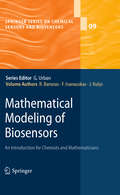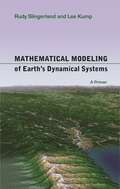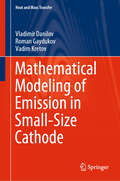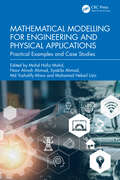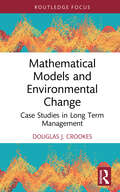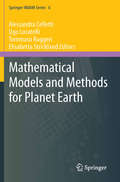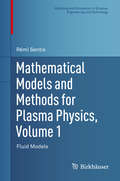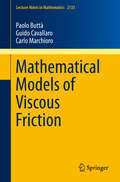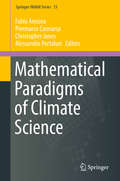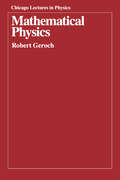- Table View
- List View
Mathematical Modeling in Physical Sciences: 12th IC-MSQUARE, Belgrade, Serbia, August 28–31, 2023 (Springer Proceedings in Mathematics & Statistics #446)
by Dimitrios VlachosThis volume gathers selected papers presented at the ICMSQUARE 2023 - 12th International Conference on Mathematical Modeling in Physical Sciences held in Belgrade, Serbia from August 28–31, 2023. This proceedings offers a compilation of cutting-edge research, which aims to advance the knowledge and development of high-quality research in mathematical fields related to physics, chemistry, biology, medicine, economics, environmental sciences, and more. Annually held since 2012, the ICMSQUARE conference serves as a platform for the exchange of ideas and discussions on the latest technological trends in these fields. This book is an invaluable resource for researchers, academicians, and professionals in these areas seeking to stay up-to-date with the latest developments in mathematical modeling.
Mathematical Modeling of Biosensors
by Juozas Kulys Romas Baronas Feliksas IvanauskasThis book presents biosensor development and modeling from both a chemical and a mathematical point of view. It contains unique modeling methods for catalytical (amperometric, potentiometer and optical) biosensors. It examines processes that occur in the sensors' layers and at their interface, and it provides analytical and numerical methods to solve enzymatic kinetic and diffusion equations. The action of single enzyme as well as polyenzyme biosensors is studied, and the modeling of biosensors that contain perforated membranes and multipart mass transport profiles is critically investigated. Furthermore, it is fully described how signals can be biochemically amplified, how cascades of enzymatic substrate conversion are triggered, and how signals are processed via a chemometric approach and artificial neuronal networks. The results of digital modeling are compared with both proximal analytical solutions and experimental data.
Mathematical Modeling of Biosensors: An Introduction For Chemists And Mathematicians (Springer Series on Chemical Sensors and Biosensors #9)
by Juozas Kulys Romas Baronas Feliksas IvanauskasThis newly designed and enlarged edition offers an up-to-date presentation of biosensor development and modeling from both a chemical and a mathematical point of view. An entire new chapter in particular is dedicated to optimal design of biosensors. Two more new chapters discuss biosensors which utilize microbial cells and are based on carbon nanotubes respectively. All the other chapters have been revised and updated. The book contains unique modeling methods for amperometric, potentiometric and optical biosensors based mainly on biocatalysts . It examines processes that occur in the sensors' layers and at their interface, and it provides analytical and numerical methods to solve equations of conjugated enzymatic (chemical) and diffusion processes. The action of single enzyme as well as polyenzyme biosensors and biosensors based on chemically modified electrodes is studied. The modeling of biosensors that contain perforated membranes and multipart mass transport profiles is critically investigated. Furthermore, it is fully described how signals can be biochemically amplified, how cascades of enzymatic substrate conversion are triggered, and how signals are processed via a chemometric approach and artificial neuronal networks. The results of digital modeling are compared with both proximal analytical solutions and experimental data.
Mathematical Modeling of Earth's Dynamical Systems: A Primer
by Lee Kump Rudy SlingerlandA concise guide to representing complex Earth systems using simple dynamic modelsMathematical Modeling of Earth's Dynamical Systems gives earth scientists the essential skills for translating chemical and physical systems into mathematical and computational models that provide enhanced insight into Earth's processes. Using a step-by-step method, the book identifies the important geological variables of physical-chemical geoscience problems and describes the mechanisms that control these variables.This book is directed toward upper-level undergraduate students, graduate students, researchers, and professionals who want to learn how to abstract complex systems into sets of dynamic equations. It shows students how to recognize domains of interest and key factors, and how to explain assumptions in formal terms. The book reveals what data best tests ideas of how nature works, and cautions against inadequate transport laws, unconstrained coefficients, and unfalsifiable models. Various examples of processes and systems, and ample illustrations, are provided. Students using this text should be familiar with the principles of physics, chemistry, and geology, and have taken a year of differential and integral calculus.Mathematical Modeling of Earth's Dynamical Systems helps earth scientists develop a philosophical framework and strong foundations for conceptualizing complex geologic systems.Step-by-step lessons for representing complex Earth systems as dynamical modelsExplains geologic processes in terms of fundamental laws of physics and chemistryNumerical solutions to differential equations through the finite difference techniqueA philosophical approach to quantitative problem-solvingVarious examples of processes and systems, including the evolution of sandy coastlines, the global carbon cycle, and much moreProfessors: A supplementary Instructor's Manual is available for this book. It is restricted to teachers using the text in courses. For information on how to obtain a copy, refer to: http://press.princeton.edu/class_use/solutions.html
Mathematical Modeling of Emission in Small-Size Cathode (Heat and Mass Transfer)
by Vladimir Danilov Roman Gaydukov Vadim KretovThis book deals with mathematical modeling, namely, it describes the mathematical model of heat transfer in a silicon cathode of small (nano) dimensions with the possibility of partial melting taken into account. This mathematical model is based on the phase field system, i.e., on a contemporary generalization of Stefan-type free boundary problems. The approach used is not purely mathematical but is based on the understanding of the solution structure (construction and study of asymptotic solutions) and computer calculations. The book presents an algorithm for numerical solution of the equations of the mathematical model including its parallel implementation. The results of numerical simulation concludes the book. The book is intended for specialists in the field of heat transfer and field emission processes and can be useful for senior students and postgraduates.
Mathematical Modeling of Protein Complexes (Biological and Medical Physics, Biomedical Engineering)
by Kirill Kulikov Tatiana KoshlanThis book is devoted to the physical and mathematical modeling of the formation of complexes of protein molecules. The models developed show remarkable sensitivity to the amino acid sequences of proteins, which facilitates experimental studies and allows one to reduce the associated costs by reducing the number of measurements required according to the developed criteria. These models make it possible to reach a conclusion about the interactions between different amino acid chains and to identify more stable sites on proteins. The models also take the phosphorylation of amino acid residues into account. At the end of the book, the authors present possible directions of application of their physical and mathematical models in clinical medicine.
Mathematical Modeling of Shock-Wave Processes in Condensed Matter: From Statistical Thermodynamics to Control Theory (Shock Wave and High Pressure Phenomena)
by Tatiana Aleksandrovna KhantulevaThis book offers an interdisciplinary theoretical approach based on non-equilibrium statistical thermodynamics and control theory for mathematically modeling shock-induced out-of-equilibrium processes in condensed matter. The book comprises two parts. The first half of the book establishes the theoretical approach, reviewing fundamentals of non-equilibrium statistical thermodynamics and control theory of adaptive systems. The latter half applies the presented approach to a problem on shock-induced plane wave propagation in condensed matter. The result successfully reproduces the observed feature of waveform propagation in experiments, which conventional continuous mechanics cannot access. Further, the consequent stress–strain relationships derived with relaxation and inertia effect in elastic–plastic transition determines material properties in transient regimes.
Mathematical Modeling of Unsteady Inviscid Flows (Interdisciplinary Applied Mathematics #50)
by Jeff D. EldredgeThis book builds inviscid flow analysis from an undergraduate-level treatment of potential flow to the level required for research. The tools covered in this book allow the reader to develop physics-based mathematical models for a variety of flows, including attached and separated flows past wings, fins, and blades of various shapes undergoing arbitrary motions. The book covers all of the ingredients of these models: the solution of potential flows about arbitrary body shapes in two- and three-dimensional contexts, with a particular focus on conformal mapping in the plane; the decomposition of the flow into contributions from ambient vorticity and body motion; generalized edge conditions, of which the Kutta condition is a special case; and the calculation of force and moment, with extensive treatments of added mass and the influence of fluid vorticity. The book also contains an extensive primer with all of the necessary mathematical tools. The concepts are demonstrated on several example problems, both classical and modern.
Mathematical Modelling for Engineering and Physical Applications: Practical Examples and Case Studies
by Mohd Hafiz Mohd Md Yushalify Misro Syakila Ahmad Noor Atinah Ahmad Mohamad Hekarl UzirThis edited volume from mathematical modelling experts employs a structured approach to showcase the latest research and provide a comprehensive guide to the principles, techniques and practical applications of mathematical modelling in the fields of engineering and the physical sciences.Readers will gain an insight into the fundamentals of mathematical modelling, its application in engineering and the physical sciences, recent advances in the field, real-world case studies and challenges and future directions in the field. The book first introduces readers to the fundamentals of mathematical modelling, including the definition, scope and steps involved in the modelling process. Mathematical tools and techniques relevant to modelling are explained. The book then addresses the application of mathematical modelling in engineering and the physical sciences. It covers various domains, such as mechanical, biomedical, chemical, computer and environmental engineering, as well as green energy, physics and other physical science applications. Furthermore, the book explores the integration of data-driven approaches, leveraging the power of big data and analytics to enhance modelling capabilities. Through real-life case studies, readers gain practical insights into how mathematical modelling is applied in various industries and scientific disciplines. These case studies analyse the modelling process, challenges faced and outcomes achieved. Readers will gain a solid foundation to develop effective mathematical models and apply them to solve complex engineering and physical problems. This foundation will also enable them to tackle problems and make informed decisions in their own projects. Finally, readers will be able to anticipate and adapt to evolving technologies and stay ahead in their respective fields.This book is a valuable resource primarily for undergraduate and graduate students seeking a comprehensive guide to this important discipline. Researchers, engineers and scientists will also benefit from the discussions within. Overall, the book empowers readers with the knowledge, skills and practical insights to effectively apply mathematical modelling in engineering and the physical sciences.
Mathematical Modelling of Chromosome Replication and Replicative Stress
by Jens KarschauDNA replication is arguably the most crucial process at work in living cells. It is the mechanism by which organisms pass their genetic information from one generation to the next and life on Earth would be unthinkable without it. Despite the discovery of DNA structure in the 1950s, the mechanism of its replication remains rather elusive. This work makes important contributions to this line of research. In particular, it addresses two key questions in the area of DNA replication: which evolutionary forces drive the positioning of replication origins in the chromosome and how is the spatial organization of replication factories achieved inside the nucleus of a cell?. A cross-disciplinary approach uniting physics and biology is at the heart of this research. Along with experimental support, statistical physics theory produces optimal origin positions and provides a model for replication fork assembly in yeast. Advances made here can potentially further our understanding of disease mechanisms such as the abnormal replication in cancer.
Mathematical Models (Wiley-iste Ser.)
by Jean-Michel TanguyThis series of five volumes proposes an integrated description of physical processes modeling used by scientific disciplines from meteorology to coastal morphodynamics. Volume 1 describes the physical processes and identifies the main measurement devices used to measure the main parameters that are indispensable to implement all these simulation tools. Volume 2 presents the different theories in an integrated approach: mathematical models as well as conceptual models, used by all disciplines to represent these processes. Volume 3 identifies the main numerical methods used in all these scientific fields to translate mathematical models into numerical tools. Volume 4 is composed of a series of case studies, dedicated to practical applications of these tools in engineering problems. To complete this presentation, volume 5 identifies and describes the modeling software in each discipline.
Mathematical Models and Environmental Change: Case Studies in Long Term Management (Routledge Focus on Environment and Sustainability)
by Douglas J. CrookesThis book demonstrates how mathematical models constructed in system dynamics modelling platforms, such as Vensim, can be used for long-term management of environmental change. It is divided into two sections, with the first dedicated to theory, where the theory of co-evolutionary modelling and its use in the system dynamics model platform is developed. The book takes readers through the steps in the modelling process, different validation tools applicable to these types of models and different growth specification, as well as how to curve fit using numerical methods in Vensim. Section 2 comprises of a collection of applied case studies, including fisheries, game theory and wildlife management. The book concludes with lessons from the use of co-evolutionary models for long-term natural resource management. The book will be of great interest to students and scholars of environmental economics, natural resource management, system dynamics, ecological modelling and bioeconomics.
Mathematical Models and Methods for Planet Earth
by Alessandra Celletti Ugo Locatelli Tommaso Ruggeri Elisabetta StricklandIn 2013 several scientific activities have been devoted to mathematical researches for the study of planet Earth. The current volume presents a selection of the highly topical issues presented at the workshop "Mathematical Models and Methods for Planet Earth", held in Roma (Italy), in May 2013. The fields of interest span from impacts of dangerous asteroids to the safeguard from space debris, from climatic changes to monitoring geological events, from the study of tumor growth to sociological problems. In all these fields the mathematical studies play a relevant role as a tool for the analysis of specific topics and as an ingredient of multidisciplinary problems. To investigate these problems we will see many different mathematical tools at work: just to mention some, stochastic processes, PDE, normal forms, chaos theory.
Mathematical Models and Methods for Plasma Physics, Volume 1
by Rémi SentisThis monograph is dedicated to the derivation and analysis of fluid models occurring in plasma physics. It focuses on models involving quasi-neutrality approximation, problems related to laser propagation in a plasma, and coupling plasma waves and electromagnetic waves. Applied mathematicians will find a stimulating introduction to the world of plasma physics and a few open problems that are mathematically rich. Physicists who may be overwhelmed by the abundance of models and uncertain of their underlying assumptions will find basic mathematical properties of the related systems of partial differential equations. A planned second volume will be devoted to kinetic models. First and foremost, this book mathematically derives certain common fluid models from more general models. Although some of these derivations may be well known to physicists, it is important to highlight the assumptions underlying the derivations and to realize that some seemingly simple approximations turn out to be more complicated than they look. Such approximations are justified using asymptotic analysis wherever possible. Furthermore, efficient simulations of multi-dimensional models require precise statements of the related systems of partial differential equations along with appropriate boundary conditions. Some mathematical properties of these systems are presented which offer hints to those using numerical methods, although numerics is not the primary focus of the book.
Mathematical Models of Plant-Herbivore Interactions (Chapman & Hall/CRC Mathematical Biology Series)
by Zhilan Feng Donald DeAngelisMathematical Models of Plant-Herbivore Interactions addresses mathematical models in the study of practical questions in ecology, particularly factors that affect herbivory, including plant defense, herbivore natural enemies, and adaptive herbivory, as well as the effects of these on plant community dynamics. <P><P> The result of extensive research on the use of mathematical modeling to investigate the effects of plant defenses on plant-herbivore dynamics, this book describes a toxin-determined functional response model (TDFRM) that helps explains field observations of these interactions. <P><P> This book is intended for graduate students and researchers interested in mathematical biology and ecology.
Mathematical Models of Viscous Friction
by Paolo Buttà Guido Cavallaro Carlo MarchioroIn this monograph we present a review of a number of recent results on the motion of a classical body immersed in an infinitely extended medium and subjected to the action of an external force. We investigate this topic in the framework of mathematical physics by focusing mainly on the class of purely Hamiltonian systems, for which very few results are available. We discuss two cases: when the medium is a gas and when it is a fluid. In the first case, the aim is to obtain microscopic models of viscous friction. In the second, we seek to underline some non-trivial features of the motion. Far from giving a general survey on the subject, which is very rich and complex from both a phenomenological and theoretical point of view, we focus on some fairly simple models that can be studied rigorously, thus providing a first step towards a mathematical description of viscous friction. In some cases, we restrict ourselves to studying the problem at a heuristic level, or we present the main ideas, discussing only some aspects of the proof if it is prohibitively technical. This book is principally addressed to researchers or PhD students who are interested in this or related fields of mathematical physics.
Mathematical Morphology in Geomorphology and GISci
by Behara Seshadri Daya SagarMathematical Morphology in Geomorphology and GISci presents a multitude of mathematical morphological approaches for processing and analyzing digital images in quantitative geomorphology and geographic information science (GISci). Covering many interdisciplinary applications, the book explains how to use mathematical morphology not only to perform
Mathematical Optics: Classical, Quantum, and Computational Methods
by Vasudevan Lakshminarayanan Maria L. Calvo Tatiana AlievaGoing beyond standard introductory texts, Mathematical Optics: Classical, Quantum, and Computational Methods brings together many new mathematical techniques from optical science and engineering research. Profusely illustrated, the book makes the material accessible to students and newcomers to the field. Divided into six parts, the text presents state-of-the-art mathematical methods and applications in classical optics, quantum optics, and image processing. Part I describes the use of phase space concepts to characterize optical beams and the application of dynamic programming in optical waveguides. Part II explores solutions to paraxial, linear, and nonlinear wave equations. Part III discusses cutting-edge areas in transformation optics (such as invisibility cloaks) and computational plasmonics. Part IV uses Lorentz groups, dihedral group symmetry, Lie algebras, and Liouville space to analyze problems in polarization, ray optics, visual optics, and quantum optics. Part V examines the role of coherence functions in modern laser physics and explains how to apply quantum memory channel models in quantum computers. Part VI introduces super-resolution imaging and differential geometric methods in image processing. As numerical/symbolic computation is an important tool for solving numerous real-life problems in optical science, many chapters include Mathematica® code in their appendices. The software codes and notebooks as well as color versions of the book’s figures are available at www.crcpress.com.
Mathematical Paradigms of Climate Science
by Christopher Jones Piermarco Cannarsa Fabio Ancona Alessandro PortaluriThis book, featuring a truly interdisciplinary approach, provides an overview of cutting-edge mathematical theories and techniques that promise to play a central role in climate science. It brings together some of the most interesting overview lectures given by the invited speakers at an important workshop held in Rome in 2013 as a part of MPE2013 ("Mathematics of Planet Earth 2013"). The aim of the workshop was to foster the interaction between climate scientists and mathematicians active in various fields linked to climate sciences, such as dynamical systems, partial differential equations, control theory, stochastic systems, and numerical analysis. Mathematics and statistics already play a central role in this area. Likewise, computer science must have a say in the efforts to simulate the Earth's environment on the unprecedented scale of petabytes. In the context of such complexity, new mathematical tools are needed to organize and simplify the approach. The growing importance of data assimilation techniques for climate modeling is amply illustrated in this volume, which also identifies important future challenges.
Mathematical Physical Chemistry: Practical and Intuitive Methodology
by Shu HottaThe second edition of this book has been extensively revised so that readers can gain ready access to advanced topics of mathematical physics including the theory of analytic functions and continuous groups. This easy accessibility helps to create a deeper and clearer insight into mathematical physics, with emphasis on quantum mechanics and electromagnetism along with the theory of linear vector spaces and group theory. The basic nature of the book remains unchanged. The contents are targeted at graduate and undergraduate students majoring in chemistry to supply them with the practical and intuitive methodology of mathematical physics. In parallel, advanced mathematical topics are dealt with in the last chapters of each of the four individual parts so that a close connection among those topics is highlighted. Several important revisions are found in this second edition, however, and they include: (a) a description of set theory and topology that helps to comprehend the essence of the theory of analytic functions and continuous groups; (b) a deep connection between angular momenta and continuous groups; (c) development of the theory of exponential functions of matrices, which is useful to solve differential equations; and (d) updated content on lasers and their applications. This new edition thus provides a balanced selection of new and basic material for chemists and physicists.
Mathematical Physical Chemistry: Practical and Intuitive Methodology
by Shu HottaThe third edition of this book has been updated so that both advanced physics and advanced chemistry can be overviewed from a modern mathematical perspective in a single integrated book. Nowadays key research arears in physics and chemistry such as materials science, molecular science, and device physics are drawing closer and closer together and becoming more and more mathematical. Hence, while retaining the basic feature, the contents are targeted at graduate and undergraduate students majoring in not only chemistry but also physics and engineering. The book covers topics ranging from classical physics (e.g., electromagnetism and analytical mechanics) to quantum science. The latter topic includes an introduction to the quantum theory of fields as well as standard quantum mechanics and quantum chemistry. Tangible examples help readers to understand abstract concepts about the topics covered. Several major revisions have been made and they contain: (a) constitution of the Dirac equation; (b) quantization of the fields; (c) interaction between the quantum fields; (d) basic formalism related to the extended vector spaces and the transformation properties of the Dirac equation; (e) advanced topics of Lie algebra. The new edition thus supplies chemists, physicists, and engineers with fundamental knowledge and calculation methodology of mathematical physics.
Mathematical Physics (Chicago Lectures in Physics)
by Robert GerochMathematical Physics is an introduction to such basic mathematical structures as groups, vector spaces, topological spaces, measure spaces, and Hilbert space. Geroch uses category theory to emphasize both the interrelationships among different structures and the unity of mathematics. Perhaps the most valuable feature of the book is the illuminating intuitive discussion of the "whys" of proofs and of axioms and definitions. This book, based on Geroch's University of Chicago course, will be especially helpful to those working in theoretical physics, including such areas as relativity, particle physics, and astrophysics.
Mathematical Physics and Its Interactions: In Honor of the 60th Birthday of Tohru Ozawa, Tokyo, Japan, August 2021 (Springer Proceedings in Mathematics & Statistics #451)
by Shuji MachiharaThis publication comprises research papers contributed by the speakers, primarily based on their planned talks at the meeting titled 'Mathematical Physics and Its Interactions,' initially scheduled for the summer of 2021 in Tokyo, Japan. It celebrates Tohru Ozawa's 60th birthday and his extensive contributions in many fields.The works gathered in this volume explore interactions between mathematical physics, various types of partial differential equations (PDEs), harmonic analysis, and applied mathematics. They are authored by research leaders in these fields, and this selection honors the spirit of the workshop by showcasing cutting-edge results and providing a forward-looking perspective through discussions of problems, with the goal of shaping future research directions.Originally planned as an in-person gathering, this conference had to change its format due to limitations imposed by COVID, more precisely to avoid inducing people into unnecessary vaccinations.
Mathematical Physics for Nuclear Experiments
by Andrew E. EkpenyongMathematical Physics for Nuclear Experiments presents an accessible introduction to the mathematical derivations of key equations used in describing and analysing results of typical nuclear physics experiments. Instead of merely showing results and citing texts, crucial equations in nuclear physics such as the Bohr’s classical formula, Bethe’s quantum mechanical formula for energy loss, Poisson, Gaussian and Maxwellian distributions for radioactive decay, and the Fermi function for beta spectrum analysis, among many more, are presented with the mathematical bases of their derivation and with their physical utility. This approach provides readers with a greater connection between the theoretical and experimental sides of nuclear physics. The book also presents connections between well-established results and ongoing research. It also contains figures and tables showing results from the author’s experiments and those of his students to demonstrate experimental outcomes. This is a valuable guide for advanced undergraduates and early graduates studying nuclear instruments and methods, medical and health physics courses as well as experimental particle physics courses. Key features Contains over 500 equations connecting theory with experiments. Presents over 80 examples showing physical intuition and illustrating concepts. Includes 80 exercises, with solutions, showing applications in nuclear and medical physics.
Mathematical Physics: A Modern Introduction to Its Foundations
by Sadri HassaniThe goal of this book is to expose the reader to the indispensable role that mathematics---often very abstract---plays in modern physics. Starting with the notion of vector spaces, the first half of the book develops topics as diverse as algebras, classical orthogonal polynomials, Fourier analysis, complex analysis, differential and integral equations, operator theory, and multi-dimensional Green's functions. The second half of the book introduces groups, manifolds, Lie groups and their representations, Clifford algebras and their representations, and fiber bundles and their applications to differential geometry and gauge theories. This second edition is a substantial revision of the first one with a complete rewriting of many chapters and the addition of new ones, including chapters on algebras, representation of Clifford algebras and spinors, fiber bundles, and gauge theories. The spirit of the first edition, namely the balance between rigor and physical application, has been maintained, as is the abundance of historical notes and worked out examples that demonstrate the "unreasonable effectiveness of mathematics" in modern physics. Einstein has famously said, "The most incomprehensible thing about nature is that it is comprehensible." What he had in mind was reiterated in another one of his famous quotes concerning the question of how " ... mathematics, being after all a product of human thought, is so admirably appropriate to the objects of reality." It is a question that comes to everyone's mind when encountering the highly abstract mathematics required for a deep understanding of modern physics. It is the experience that Eugene Wigner so profoundly described as "the unreasonable effectiveness of mathematics in the natural sciences." Some praise for the previous edition: PAGEOPH [Pure and Applied Geophysics] Review by Daniel Wojcik, University of Maryland "This volume should be a welcome addition to any collection. The book is well written and explanations are usually clear. Lives of famous mathematicians and physicists are scattered within the book. They are quite extended, often amusing, making nice interludes. Numerous exercises help the student practice the methods introduced. ... I have recently been using this book for an extended time and acquired a liking for it. Among all the available books treating mathematical methods of physics this one certainly stands out and assuredly it would suit the needs of many physics readers." ZENTRALBLATT MATH Review by G.Roepstorff, University of Aachen, Germany "... Unlike most existing texts with the same emphasis and audience, which are merely collections of facts and formulas, the present book is more systematic, self-contained, with a level of presentation that tends to be more formal and abstract. This entails proving a large number of theorems, lemmas, and corollaries, deferring most of the applications that physics students might be interested in to the example sections in small print. Indeed, there are 350 worked-out examples and about 850 problems. ... A very nice feature is the way the author intertwines the formalism with the life stories and anecdotes of some mathematicians and physicists, leading at their times. As is often the case, the historical view point helps to understand and appreciate the ideas presented in the text. ... For the physics student in the middle of his training, it will certainly prove to be extremely useful." THE PHYSICIST Review by Paul Davies, Orion Productions, Adelaide, Australia "I am pleased to have so many topics collected in a single volume. All the tricks are there of course, but supported by sufficient rigour and substantiation to make the dedicated mathematical physicist sigh with delight." EMS [EUROPEAN MATHEMATICAL SOCIETY] NEWSLETTER "This book is a condensed exposition of the mathematics that is met in most parts of physics. The presentation attains a very good balance between the formal introduction of concepts, theorems and proofs on one hand, and the applied approach on the other, with many examples, fully...

